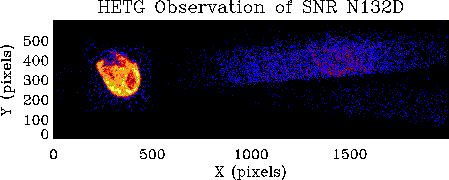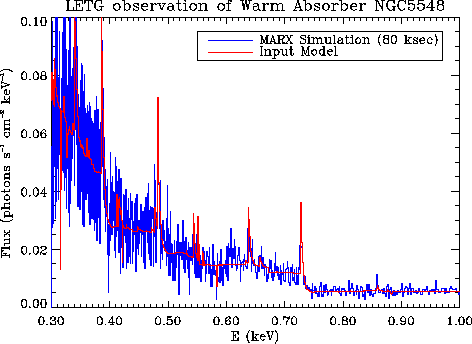



Next: The Observation Visualizer
Up: AXAF News
Previous: LETG Spectra
When AXAF launches, it will provide users with some of the
most powerful X-ray instruments ever flown.
AXAF's superior spatial and spectral resolution
will allow observers to attack a variety of scientific
questions which previous missions could not address.
This power however is not without its price.
With these expanded capabilities comes an increased complexity in terms
of observation planning and data analysis.
To assist potential AXAF observers with these tasks, the AXAF Science
Center (ASC) Data Analysis System (ASCDS) will include software to simulate
the detailed response of the AXAF observatory to X-ray sources.
As part of this modeling effort, the AXAF Science Center group
at MIT is currently developing a modular, portable, stand-alone
AXAF simulator called MARX (Model of AXAF Response
to X-rays).
MARX consists of a suite of programs designed to enable the user to
simulate the on-orbit performance of AXAF.
With the appropriate configuration, MARX can also be used to simulate
calibration data taken at the XRCF facility in Huntsville, AL.
It is built around a core program or engine which performs a
raytrace of photon paths through all elements of the AXAF
observatory.
To run a simulation with MARX, the user specifies a file containing
the spectral energy distribution of the source to be simulated
and then selects a model for the spatial distribution of the source.
Sources can be either on- or off-axis.
At present, MARX provides a number of built-in models for the
spatial distribution of source photons including point sources,
Gaussians, and Beta models (often used to model clusters of galaxies).
Alternatively, a FITS image can be used to specify the spatial
distribution of source photons.
User supplied source models can also be linked dynamically to allow
expansion of MARX's capabilities.

Figure 30: A MARX simulation of the supernova remnant N132D as observed with
the ACIS imager. The input to MARX consisted of a deconvolved ROSAT HRI FITS
image. AXAF's spatial resolution will actually be capable of resolving finer
structure in the remnant than this image depicts.
Once the source has been specified, MARX traces the path of photons
through a model of the HRMA onboard AXAF.
This model is currently being tuned to match the results of the
HRMA calibration at XRCF.
If desired, models for the High Energy Transmission Grating (HETG) and
Low Energy Transmission Grating (LETG) can be also be included
to simulate AXAF's high resolution spectroscopy capabilities.
In the focal plane, the user has the choice of all four AXAF detectors
(ACIS-I, ACIS-S, HRC-I, and HRC-S)
including a model of the High Energy Suppression Filter (HESF)
attached to the HRC-S.
These models will also be tuned to match XRCF calibration results
as these data become available.
To illustrate some of MARX's capabilities, we have included a few examples
of some typical science simulations created with the suite.
These samples are shown in Figures 30-33.
The MARX suite consists of a set of UNIX executables and
has been successfully built under SunOS, Solaris, Linux, HP/Unix,
and NeXT systems.
Control of the program is accomplished through a parameter file
utilizing a custom version of the SAO/IRAF parameter interface library.
The user can either edit this parameter file directly or modify
MARX parameters on the call line.
For example, the command:
[1]unix% marx ExposureTime=50000
GratingType=`HETG'
DetectorType=`ACIS-S'
SourceType=`POINT'
would run a 50 ksec simulation of a point source as observed
with the HETGS. A GUI and PERL scripts are currently being developed
to simplify user interaction with the suite. The simulator is
reasonably compact (requiring only about 32 MBytes for the entire
distribution) and fast (5000 photons/sec on an Ultra-2).

Figure 31: A simulation of the same supernova remnant as observed with the
HETGS. The image shows a section of the full ACIS-S image which is obtained.
The zeroth spectral order is seen in the left of the image while the
broad bands extending to the right represent the dispersed MEG (top) and
HEG (bottom) spectra. Images of the remnant are also visible at pixel
positions X=1400 and X= 1550 in the MEG spectrum due to bright emission
lines in the spectrum.

Figure 32: AXAF's high spectral resolution capabilities are demonstrated
in this simulation of a 60 ksec HETGS observation of the elliptical galaxy
NGC1399. The galaxy's spectrum was modeled as a 1.0 keV Raymond-Smith
plasma with 0.2 solar elemental abundances. Spatially, the galaxy's
surface brightness was modeled using MARX's built-in Beta model with
a core radius of 1 arcsec. The upper panel shows the input spectrum while
the two lower panels show the extracted MEG and HEG first order spectra,
respectively.
Output from MARX can take several forms: a directory of binary vectors
for each photon property, a FITS photon event list (from which images
and spectra may be extracted), FITS images, an SAOSAC DPDE rayfile,
or even ASCII files.
Post-processing routines can
then be run on the MARX output to include a detailed
model of ACIS CCD photon pileup or use an existing detector
response matrix file (RMF).
A set of scripts are also included for IDL users to facilitate working
with MARX output.
Although MARX is an integrated part of the ASCDS, you do not need
to install the entire data system to use it. Users can download a
UNIX TAR file containing the entire distribution from the ASC
Web Page at the following URL:
http://asc.harvard.edu/soft/
Alternatively, the distribution can be obtained via anonymous FTP at:
ftp://asc.harvard.edu/pub/software
The ASC group at MIT also maintains an informational web page on the
MARX package at
http://space.mit.edu/ASC/MARX/
including online documentation, sample parameter files,
user contributed software, and lists of frequently asked
questions (FAQs).
Installation of MARX has been designed to be as painless as possible.
Once the TAR file containing the distribution has been downloaded
and unpacked, installation is as simple as typing:
[2]unix% ./configure; make
Instructions are included with the distribution along with the
current version of the MARX User Guide.
AXAF will provide potential observers with unique and powerful
observing capabilities.
It will also present them with many new and unfamiliar instruments
and a variety of observing modes and options.
Our hope, here at MIT, is that in MARX users will find a tool which
will help them design, plan, and assess the feasibility of their
observing programs.
MARX was released by the ASC as part of the proposal planning tool
package to support the initial AXAF NRA on October 31, 1997.
Although we are continuing to develop MARX's capabilities, MARX
is available now and users are invited to download the package
and try it out.
We welcome feedback and suggestions for future enhancements.

Figure 33: In addition to the HETGS, MARX provides the capability to
simulate the LETGS instrument pair as well. This figure shows the
extracted first order spectrum for an 80 ksec observation of the
AGN NGC5548. The input spectrum consisted of a power-law plus
a ``warm'' absorber. In this figure, the extracted spectrum has
been corrected for the combined instrument response and compared
to the input spectrum indicated by the solid line.
Mike Wise




Next: The Observation Visualizer
Up: AXAF News
Previous: LETG Spectra
Roy Kilgard
Mon Dec 22 10:05:00 EST 1997



